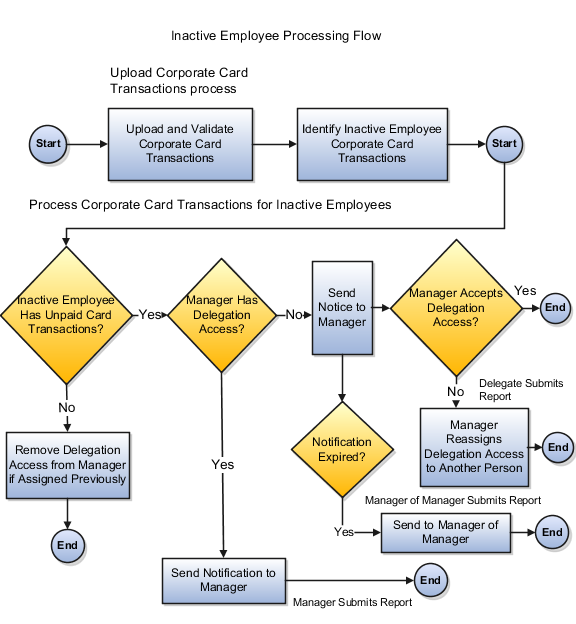How Corporate Card Transactions for Inactive Employees Are Processed
Your company can settle inactive employees' accounts with a card issuer in a timely manner. You can grant managers permission to submit their inactive employees' unpaid corporate card transactions in expense reports.
You can process corporate card transactions for inactive employees by running either of the following processes from the Corporate Cards work area:
-
Upload Corporate Card Transactions
-
Process Inactive Employee's Corporate Card Transactions
Navigate to Corporate Cards work area: Navigator > Corporate Cards link > Overview page or Navigator >Tools > Scheduled Processes.
An inactive employee is a person who was terminated or who's on unpaid leave. Examples include:
-
Military leave
-
Extended medical leave
-
Educational leave
Settings That Affect Corporate Card Transactions for Inactive Employees
No prerequisites or setup is required to process corporate card transactions for inactive employees. However based on the requirements of your organization, you can specify a grace period, which is used to determine the cutoff date for the transactions of inactive employees to be processed. For example, if transactions are posted after the employee's inactive date, setting a grace period will ensure that such transactions aren't ignored from processing. The default value of the grace period is 0 days. To change the grace period grace period for your organization, enter a value in the Inactive Employee Grace Period in Days field on the Manage Expenses System Options page. Here is how you open the page:
In the Setup and Maintenance work area, select these options:
-
Offering: Financials
-
Functional Area: Expenses
-
Task: Manage Expenses System Options
You can also specify different grace periods for specific business units.
The corporate card transaction processes for inactive employees include Both Pay, Company Pay, and Individual Pay corporate card transactions. For Both Pay transactions, your company pays the corporate card issuer for business expenses and the employee pays the corporate card issuer for personal expenses. Company Pay transactions are those where your company pays the corporate card issuer for all corporate card transactions incurred by its employees. The employee is reimbursed only for cash business expenses. Individual Pay transaction are those where the employee pays the corporate card issuer for all corporate card transactions. The employee is later reimbursed for the business expenses.
The following table describes selected parameters for the Process Inactive Employee's Corporate Card Transactions process.
|
Parameters |
Description |
|---|---|
|
Number of Days |
Value used by the application that represents an interval of time, which the application uses to determine whether corporate card transactions for inactive employees exist. The default value for Number of Days is one. However, you can adjust this value depending on how frequently your company updates information about terminated and inactive employees. If your company updates employee information infrequently, the value for Number of Days should be greater than one. Tip: A large value for Number of Days may impact performance.
It's advisable to update your employee data frequently and enter a
small value for Number of Days.
|
|
Business Unit |
Unit of an enterprise in a management hierarchy that performs one or multiple business functions. The process named Process Corporate Cards Transactions for Inactive Employees runs for the business unit identified by this parameter. |
How Corporate Card Transactions for Inactive Employees are Processed
The figure shows the different starting points of the following processes:
-
Upload Corporate Card Transactions
-
Process Inactive Employees' Corporate Card Transactions

To run the Upload Corporate Card Transactions process from the Corporate Cards work area, click the Upload Corporate Card Transactions link in the Tasks list. First, this process validates and uploads corporate card transactions to Expenses. Second, if the process identifies unpaid corporate card transactions for an inactive employee, the Process Inactive Employee's Corporate Card Transactions process initiates.
After Process Inactive Employee's Corporate Card Transactions is initiated and unpaid card transactions are found, a notification is sent to the inactive employee's manager.
If the direct manager doesn't have delegation, he receives a notification. The notification informs him that corporate card transactions exist for an inactive employee. He can either accept delegation or reassign it to another person.
If no unpaid corporate card transactions exist for an inactive employee, then delegation is removed from the manager if it was assigned previously.
If the direct manager already has delegation, he receives a notification, informing him that corporate card transactions exist for an inactive employee. The manager can then submit the unpaid corporate card transactions in an expense report on behalf of the inactive employee.
If the direct manager is also inactive, then the next level manager receives the notification. In case the next level manager is also inactive, then the users with the corporate card administrator role receive the notification. You can change this default rule by defining custom routing rules in BPM workflow to send notifications for inactive employee corporate card transactions as per the requirements of your organization.
When unpaid card transactions for inactive employees are submitted in a report and are paid, delegation is removed from the manager or other designated person.
Alternatively, you can skip the Upload Corporate Card Transactions process if it's irrelevant, and run the Process Corporate Card Transactions for Inactive Employees. To run the process, click the Process Corporate Card Transactions for Inactive Employees link in the Tasks list. This process is run using two parameters: the Business Unit with which the inactive employee was associated and a value for the Number of Days.